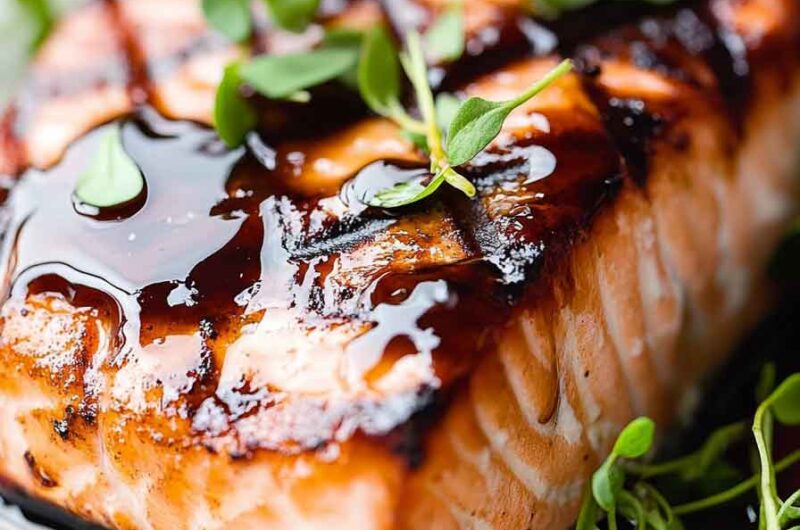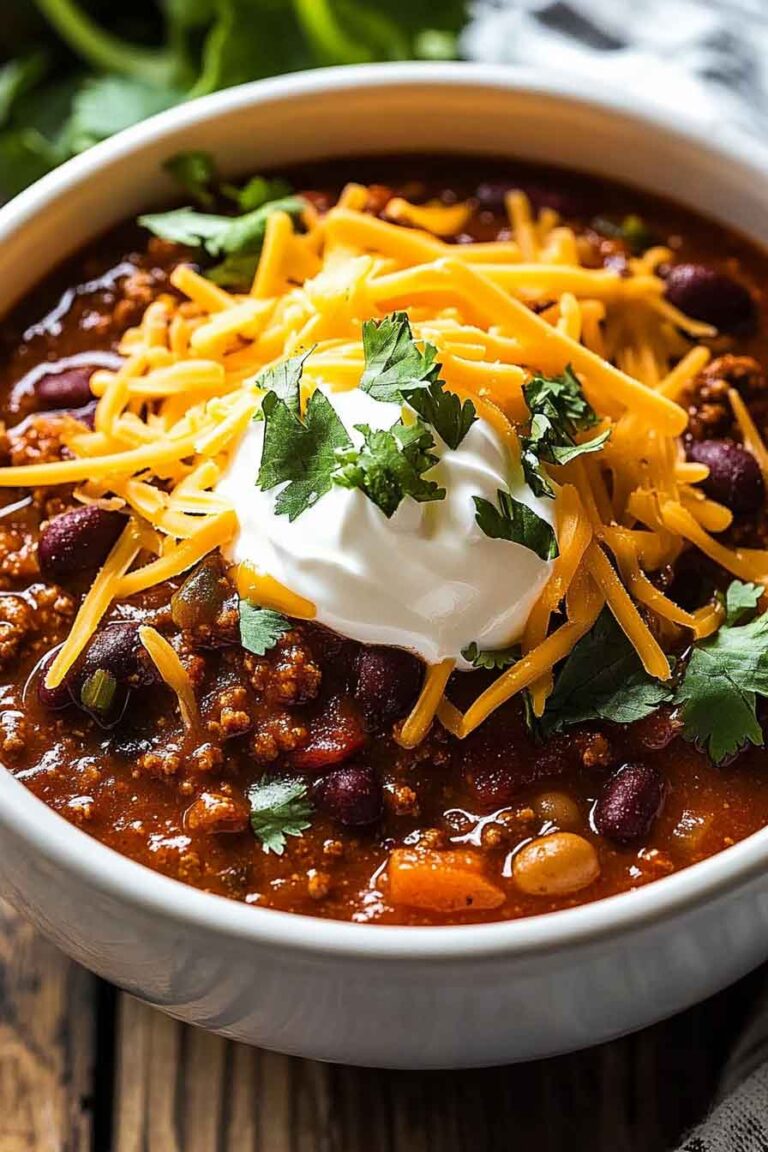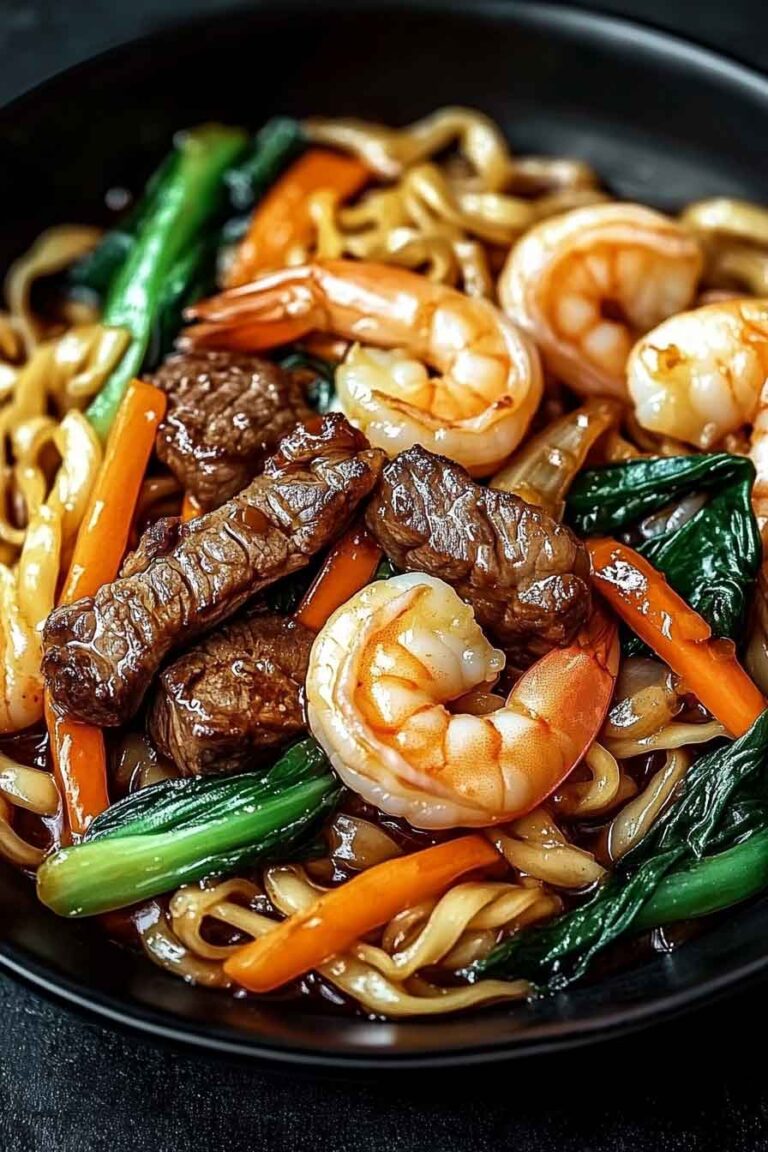Alright, this balsamic glazed salmon? It’s sweet, tangy, and perfectly caramelized on top—with tender, flaky salmon underneath. The kind of dish that looks fancy but comes together in no time.
I made it one night when I wanted something quick but full of flavor. Whisked up a simple glaze with balsamic vinegar, honey, garlic, and a touch of Dijon, then brushed it over the salmon and baked it until sticky and golden. One bite in? Total dinner win.
It’s bold, balanced, and pairs perfectly with rice, roasted veggies, or a fresh salad. If you want an easy weeknight meal that tastes like a restaurant dish, this one’s for you. Let’s get it in the oven—you’re gonna love every bite.
Why You’ll Love This Recipe
- Perfectly Balanced Flavor:
The balsamic glaze blends the dark, fruity tang of balsamic vinegar with honey’s sweetness, mustard’s gentle spice, and rosemary’s woodsy aroma. Each ingredient has a clear purpose, so the glaze enhances the salmon without overpowering its natural taste. - Quick and Manageable:
The entire process takes about 35 minutes from start to finish, with just a few minutes of hands-on work. While the glaze simmers, you can prep your salmon, so it feels effortless. - Nutritious and Satisfying:
Salmon is full of heart-healthy fats, and this recipe uses simple, fresh ingredients without heavy cream or butter. - Adaptable for Meal Prep:
Leftovers taste just as good the next day. The glaze firms up in the fridge and can be reheated without losing its flavor. - A Good Recipe for Beginners:
The steps are straightforward. The hardest part is keeping an eye on the glaze so it doesn’t boil over—easy with just a little attention.
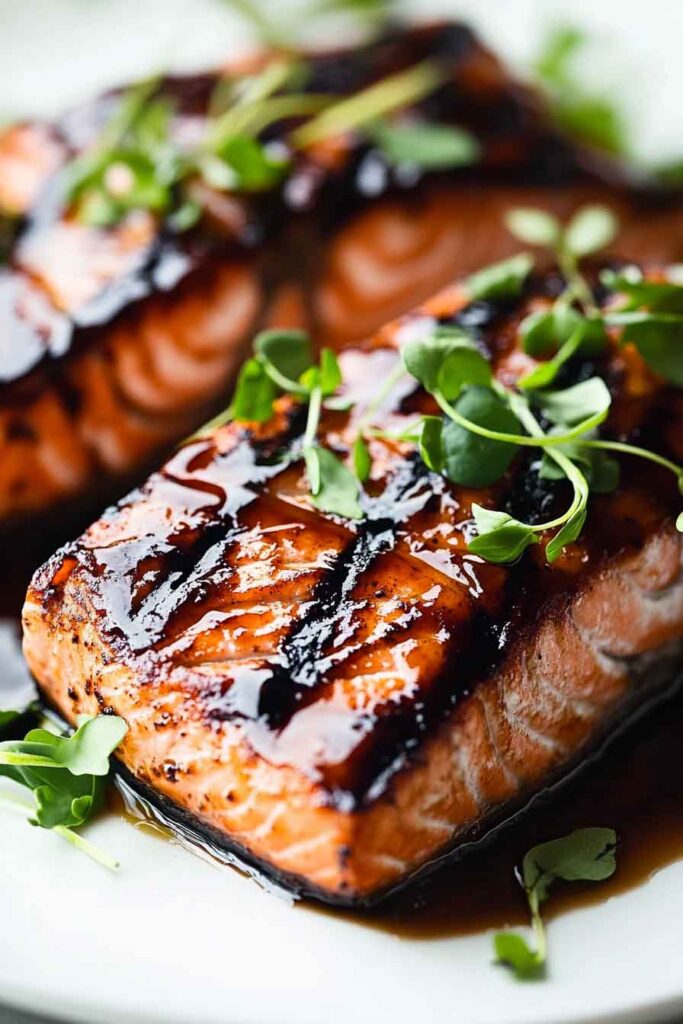
What You Need to Know Before You Start
- Prep Time: 15 minutes
(5 minutes to gather and measure ingredients, 5 minutes to make the glaze, 5 minutes to season the salmon and line the pan) - Cook Time: 20 minutes
(About 8-10 minutes for reducing the glaze and 10-12 minutes for baking, depending on salmon thickness) - Total Time: 35 minutes or less
- Servings: 4 average salmon fillets (about 5–6 ounces each)
(Easily doubled or halved. If serving smaller portions or children, you can cut larger fillets into pieces.) - Difficulty: Easy to moderate.
You only need to pay attention while reducing the glaze, as it can bubble up if left unsupervised.
Required Kitchen Tools
You won’t need any fancy gadgets for this recipe, but having these tools on hand makes things smoother:
- Small Saucepan: For simmering the glaze.
- Whisk or Spoon: To stir the glaze and help honey and mustard dissolve.
- Measuring Cups and Spoons: For precise glaze proportions.
- Baking Sheet or Oven-Safe Skillet: Lined with parchment or foil for easy cleanup.
- Pastry Brush or Spoon: To apply glaze over the salmon fillets.
- Tongs or Fish Spatula: For moving salmon without breaking it (optional, but helpful).
- Cutting Board and Chef’s Knife: For mincing garlic and rosemary.
- Small Bowl: For mixing or resting fillets before baking.
Ingredients for Balsamic Glazed Salmon
Here’s a more detailed look at each ingredient and why it matters:
- Salmon Fillets:
Look for fillets that are about 1 inch thick in the middle, with skin-on or skinless as you prefer. Fresh is ideal, but thawed frozen fillets work as well. Wild-caught salmon has more flavor, but farmed is fine for everyday use. - Balsamic Vinegar:
Aged balsamic vinegar has a natural sweetness. Use the best quality you can, but even standard grocery balsamic will work well. - Honey:
Honey thickens the glaze and adds a delicate, floral sweetness that balances the acidity of the vinegar. - Dijon Mustard:
Dijon provides mild heat and helps the glaze cling to the fish. If you only have yellow mustard, it can work in a pinch. - White Wine or Chicken Broth:
Adds liquid and complexity to the glaze. Dry white wine is best (like Sauvignon Blanc), but low-sodium chicken broth makes a good alcohol-free substitute. - Garlic (Fresh):
Use fresh cloves if you can. Mince finely for even flavor throughout the glaze. - Fresh Rosemary Sprig:
Rosemary gives a piney, herbal undertone. If you use dried rosemary, use less (about 1/2 teaspoon). - Olive Oil:
Lightly brushed over the salmon so it doesn’t stick and to add richness. - Salt and Black Pepper:
For seasoning the fillets and rounding out the glaze. - Optional Garnish:
Chopped parsley or a few rosemary leaves brighten the dish for serving.
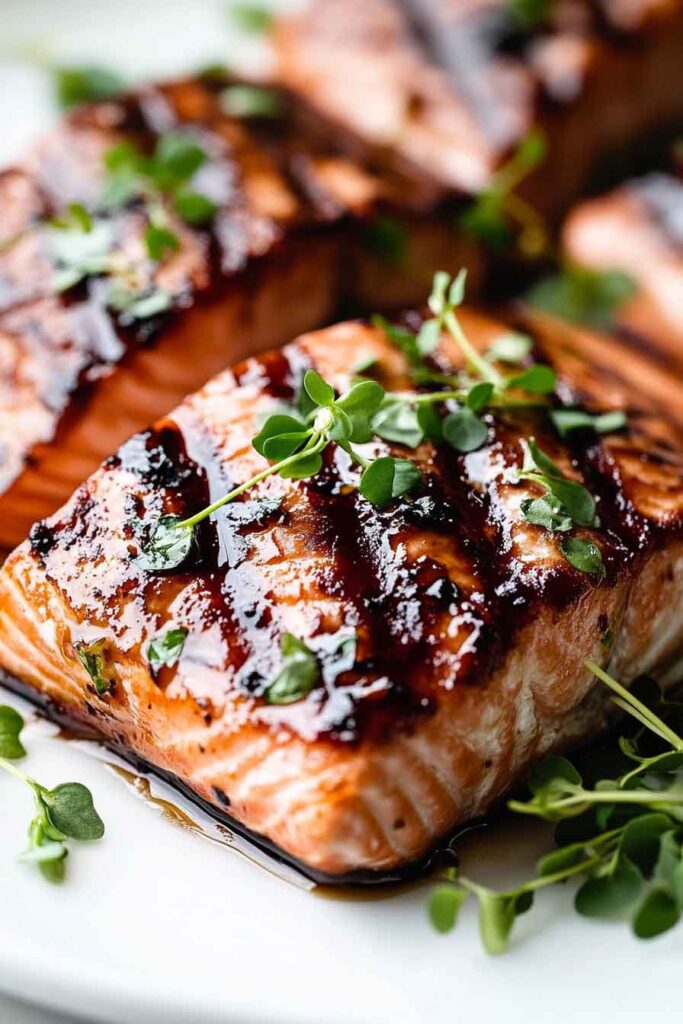
Variations for Balsamic Glazed Salmon
- Add Citrus:
Stir in 1 tablespoon of fresh orange or lemon juice to the glaze for a light, zesty twist. - Use Maple Syrup:
For a deeper, slightly earthy sweetness, swap out honey for pure maple syrup. - Try Soy Sauce:
Add 1 teaspoon soy sauce to the glaze for a savory umami boost. - Spice It Up:
Sprinkle in a pinch of crushed red pepper flakes to add gentle heat. - Herb Swap:
Substitute fresh thyme for rosemary, or use a mix of soft herbs like dill and chives for a lighter flavor.
How to Make Balsamic Glazed Salmon: Step-by-Step Instructions
1. Prep Your Ingredients
- Preheat the Oven: Set your oven to 400°F (200°C) so it’s ready when you need it.
- Line Your Pan: Line a rimmed baking sheet with parchment paper or foil. This keeps the salmon from sticking and makes cleanup easy.
- Mince & Measure: Mince the garlic and rosemary. Measure all glaze ingredients before starting—this makes everything go smoothly.
2. Make the Balsamic Glaze
- Combine Ingredients: In a small saucepan, add 1/3 cup balsamic vinegar, 2 tablespoons honey, 1 tablespoon Dijon mustard, 1/4 cup white wine (or chicken broth), minced garlic, and the rosemary sprig.
- Heat the Glaze: Set the saucepan over medium heat. Stir until the honey and mustard dissolve.
- Simmer: Bring to a gentle simmer. Let it bubble for 8–10 minutes, stirring occasionally, until the mixture reduces by about half. The glaze should coat the back of a spoon and look glossy.
- Remove Rosemary: Take out the rosemary sprig. Taste the glaze; add a pinch of salt if needed. Set aside.
3. Prepare the Salmon
- Pat Dry: Use a paper towel to pat the salmon fillets dry. This helps the glaze stick and keeps the fish from steaming in the oven.
- Season: Place the fillets skin-side down on the lined baking sheet. Rub or brush each with a small amount of olive oil, then sprinkle with salt and black pepper on both sides.
4. Glaze and Bake
- Brush with Glaze: Spoon or brush a layer of balsamic glaze over the tops of each fillet. Save some glaze for after baking.
- Bake: Put the salmon in the oven and bake for 10–12 minutes, depending on the thickness. Salmon is done when it flakes easily with a fork and the inside is just opaque.
- Finish with More Glaze: When the salmon comes out of the oven, brush with a little more glaze for extra shine and flavor.
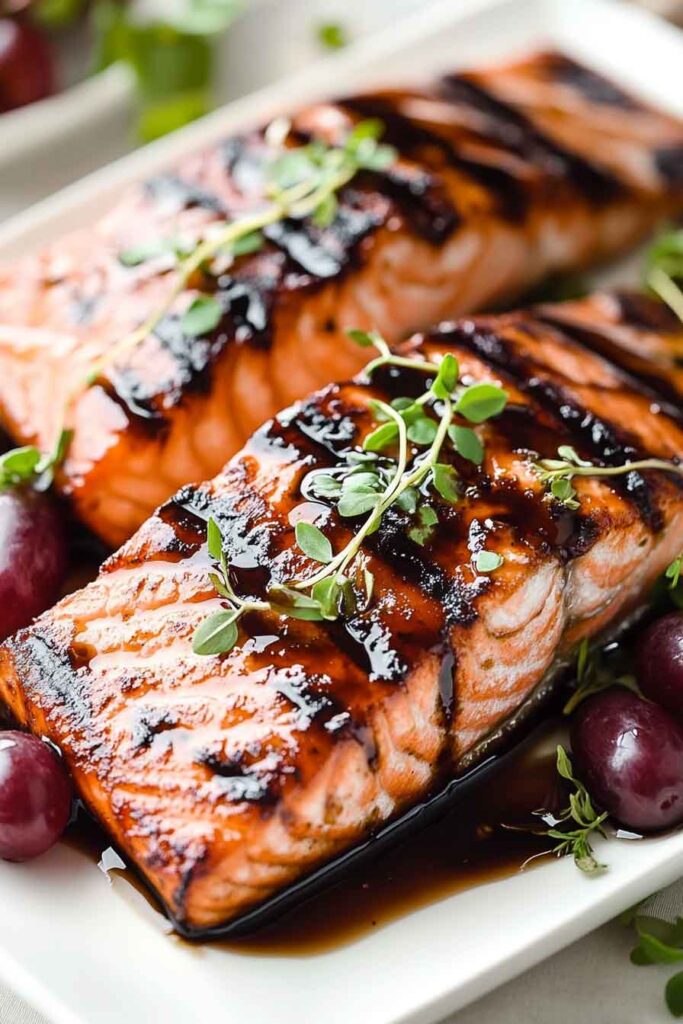
Serving and Decoration
Balsamic Glazed Salmon pairs well with simple sides that let the flavors shine. Try it with:
- Steamed or Roasted Vegetables: Green beans, asparagus, broccoli, or carrots all work.
- Rice or Quinoa: A scoop of brown rice, white rice, or quinoa soaks up any extra glaze.
- Fresh Salad: A bed of mixed greens tossed with a little olive oil and lemon is a crisp, refreshing contrast.
- Garnish: Sprinkle chopped parsley or a few rosemary leaves over the salmon before serving. A wedge of lemon on the side adds brightness.
For a more special presentation, plate each salmon fillet on a small mound of rice with vegetables around the edge and a final drizzle of glaze.
Storing Balsamic Glazed Salmon
- Refrigerate: Let leftover salmon cool, then transfer to an airtight container. Store in the fridge for up to 2 days.
- Reheat: Warm gently in the microwave or a low oven until just heated through. Drizzle with a little extra glaze if you saved any.
- Meal Prep Tip: The glaze can be made ahead and kept in the fridge for up to 1 week. Gently reheat to loosen before using.
Tips and Tricks for Success
- Watch the Glaze: Stir occasionally and keep an eye on the saucepan—balsamic glaze can bubble up quickly.
- Check for Doneness: Salmon cooks fast. It’s best when just opaque in the center. If in doubt, check with a fork—the fish should flake easily.
- Use Parchment or Foil: This helps with cleanup and prevents sticking.
- Skin-On Fillets: If using skin-on salmon, the skin will crisp slightly in the oven and makes the fillet easier to handle.
- Save Extra Glaze: Any extra glaze is delicious on roasted veggies or even drizzled over salads.
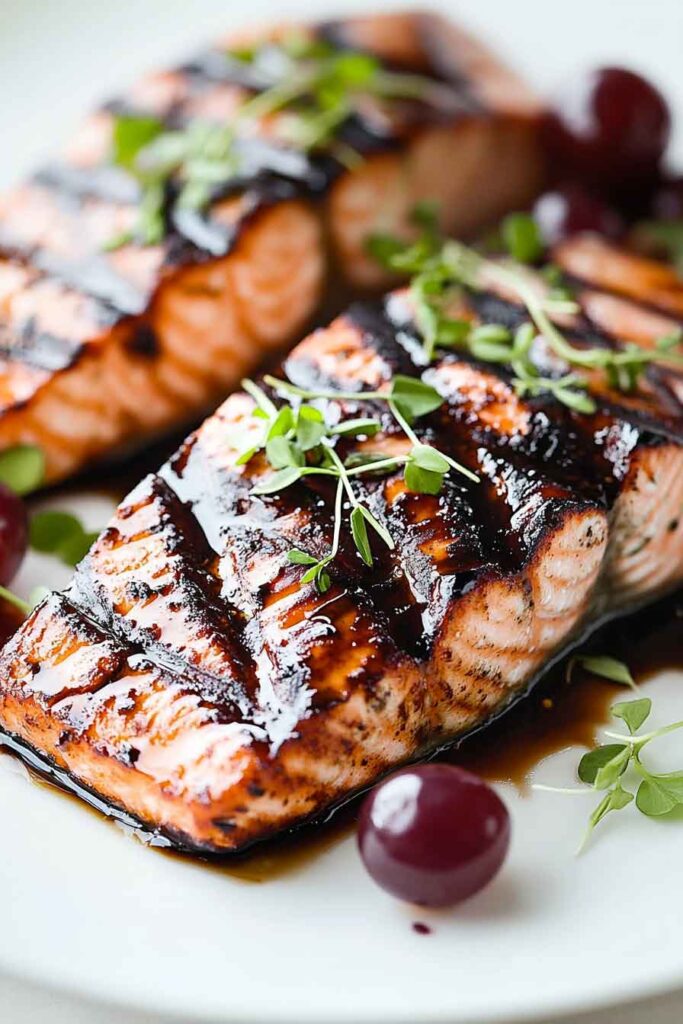
Nutrition
| Serving Size | Calories | Protein | Carbs | Fat | Fiber | Sugar |
|---|---|---|---|---|---|---|
| 1 fillet | 285 | 27g | 11g | 13g | 0g | 8g |
Nutrition values are estimates and will vary depending on the size and type of salmon and any substitutions used.
Balsamic Glazed Salmon
Course: Uncategorized4
servings15
minutes20
minutes285
kcalIngredients
4 salmon fillets (5–6 ounces each, skinless or skin-on)
1/3 cup balsamic vinegar
2 tablespoons honey
1 tablespoon Dijon mustard
1/4 cup white wine (or low-sodium chicken broth)
1 large garlic clove, minced
1 small sprig fresh rosemary (or 1/2 teaspoon dried rosemary)
1 tablespoon olive oil
1/2 teaspoon salt (more to taste)
1/4 teaspoon black pepper
Optional: Chopped parsley or extra rosemary for garnish
Directions
- Preheat the oven to 400°F (200°C). Line a baking sheet with parchment paper or foil.
- Make the glaze: In a small saucepan, combine balsamic vinegar, honey, Dijon mustard, white wine (or broth), minced garlic, and rosemary. Set over medium heat and stir until honey and mustard dissolve. Bring to a simmer and cook, stirring occasionally, until the glaze is reduced by about half and slightly thick (about 8–10 minutes). Remove rosemary. Taste and add a pinch of salt if needed. Set aside.
- Prepare salmon: Pat salmon fillets dry. Place on prepared baking sheet. Brush with olive oil, then season with salt and pepper on both sides.
- Glaze and bake: Brush the top of each fillet with a layer of balsamic glaze. Bake for 10–12 minutes, or until the salmon flakes easily with a fork and is just opaque in the center.
- Finish: Remove salmon from oven and brush with remaining glaze. Garnish with chopped parsley or rosemary, if desired. Serve hot with your favorite side.
Balsamic Glazed Salmon FAQs
1. Can I use frozen salmon fillets?
Yes. Thaw completely in the refrigerator, then pat dry before using to avoid excess moisture.
2. Can I make the glaze ahead?
Absolutely. The glaze can be made up to a week in advance. Warm gently before brushing on the salmon.
3. What if I don’t have white wine?
Chicken broth works well as a substitute and adds flavor without alcohol.
4. How do I know when salmon is done?
The fish will look just opaque and flake easily with a fork. For extra accuracy, check for an internal temperature of 125–130°F (52–54°C).
5. Can I cook the salmon on the stovetop or grill?
Yes. For stovetop, cook in a nonstick skillet over medium heat, about 3–4 minutes per side, brushing with glaze as it cooks. For grill, brush with glaze and cook on well-oiled grates until done.
Conclusion
Balsamic Glazed Salmon is a balanced, approachable recipe that’s both nutritious and elegant. The sweet-tangy glaze locks in moisture and brings out the best in salmon, making it a perfect choice for quick weeknight dinners or a special meal at home. With simple prep, easy cleanup, and flavors that work for all ages, it’s a reliable dish to keep in your recipe collection.
